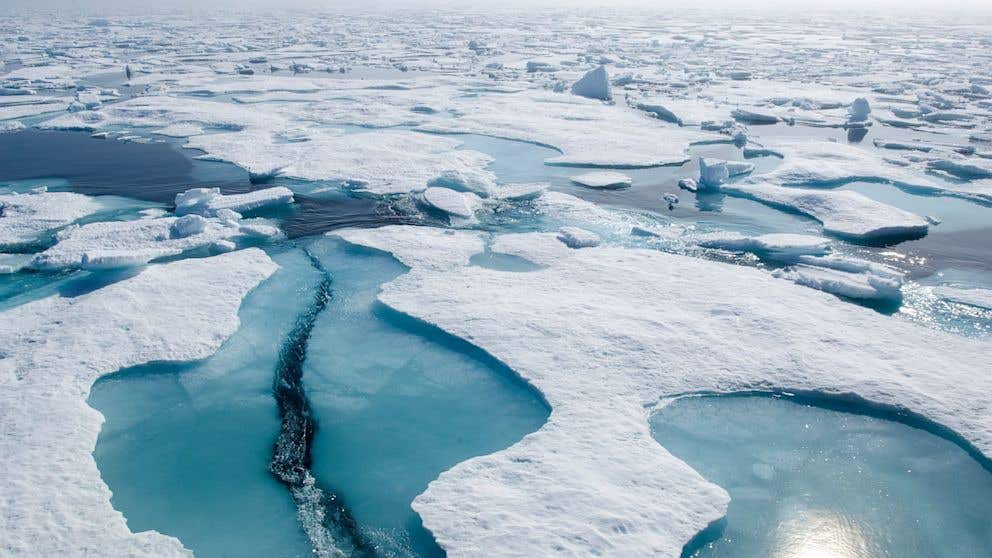Study shows 50 years of significant snow cover decline in the Northern hemisphere
Rigorous mathematical models and statistical methods found declining snow cover in many parts of the northern hemisphere.

[July 1, 2023: Emily Cerf, University of California - Santa Cruz]
At the beginning of the last ice, local mountain glaciers grew and formed large ice sheets, like the one seen here. (CREDIT: Creative Commons)
In the face of the ongoing climate crisis, scientists from many fields are directing their expertise at understanding how different climate systems have changed and will continue to do so as climate change progresses.
Robert Lund, professor and department chair of statistics at the UC Santa Cruz Baskin School of Engineering, collaborated on a new study that uses rigorous mathematical models and statistical methods and finds declining snow cover in many parts of the northern hemisphere over the last half century.
Understanding snow cover trends is important because of the role that snow plays in the global energy balance. Snow’s high albedo – the ability to reflect light – and insulating characteristics affects surface temperatures on a regional scale and thermal stability on a continent-wide scale.
In the new study published in the Journal of Hydrometeorology, researchers analyzed snow cover data gathered from weekly satellite flyovers between 1967 (when satellites became more common) and 2021, which was divided into grid sections for analysis. Of the grids that researchers determined had reliable data, they found that snow cover is declining in nearly twice as many grids as it is advancing.
Related Stories
“In the Arctic regions, snow is going away more often than not – I think climatologists sort of suspected this,” Lund said. “But it's also going away at the southern boundaries of the continents.”
In a study that took about four years to complete, the researchers show that snow presence in the Arctic and southern latitudes of the Northern hemisphere is generally decreasing, while some areas such as Eastern Canada are seeing an increase in snow cover. This could be due to increasing temperatures in areas that are typically very cold but still below freezing, allowing the atmosphere to hold more water, which then falls as snow.
Lund believes this is the first truly dependable analysis of snow cover trends in the Northern hemisphere due to the rigor of the researchers’ statistical methods. It is often challenging for non-statisticians to extract trends from this type of satellite data, which comes as a sequence of 0s or 1s to indicate if snow was present during a certain week.
NH snow coverage reported by the NH Weekly Visible Satellite Charts (Robinson et al. 2012) for the week of 1–7 Dec 2020. (CREDIT: Journal of Hydrometeorology)
The researchers also had to take correlation into account when looking at trends, as the presence of snow cover one week greatly affects the likelihood of snow cover the following week. These two factors were taken into account with a Markov chain based model. Accurate uncertainty estimates of the trends could be computed from the model. The researchers found hundreds of grids where snow cover was declining with at least 97.5% certainty.
However, they also found that some of the satellite data gathered in mountainous regions was unreliable, showing no snow in the winter and several weeks of snow in the winter. This was likely due to a flaw in the algorithm that processed the satellite data to determine if snow was present or not.
A graphical partition of this studies’ cell groups. The violet colored cells (Group 4) were deemed analyzable. (CREDIT: Journal of Hydrometeorology)
“The reason this study took a lot of work is because the satellite data is so doggone poor,” Lund said. “Whatever the meteorologists did to estimate snow from the pictures in some of the mountainous regions just didn't work, so we had to take all the grids in the Northern hemisphere, and figure out whether the data was even trustworthy or not.”
By determining which satellite data is unreliable, this study can serve as a resource to the scientific community who also may want to evaluate this snow cover data for their research.
Lund collaborated on this study with UCSC Ph.D. candidate Jiajie Kong, Assistant Professor of Math and Statistics at the University of North Florida Yisu Jia, Professor of Meteorology and Climatology at Mississippi State University Jamie Dyer, Associate Professor of Statistics at Mississippi State University Jonathan Woody, and Professor of Statistics and Operations Research at the University of North Carolina at Chapel Hill J. S. Marron. This research was supported by funding from the National Science Foundation.
For more environmental good news stories check out our Green Impact section at The Brighter Side of News.
Note: Materials provided above by University of California - Santa Cruz. Content may be edited for style and length.
Like these kind of feel good stories? Get the Brighter Side of News' newsletter.
Joseph Shavit
Head Science News Writer | Communicating Innovation & Discovery
Based in Los Angeles, Joseph Shavit is an accomplished science journalist, head science news writer and co-founder at The Brighter Side of News, where he translates cutting-edge discoveries into compelling stories for a broad audience. With a strong background spanning science, business, product management, media leadership, and entrepreneurship, Joseph brings a unique perspective to science communication. His expertise allows him to uncover the intersection of technological advancements and market potential, shedding light on how groundbreaking research evolves into transformative products and industries.



